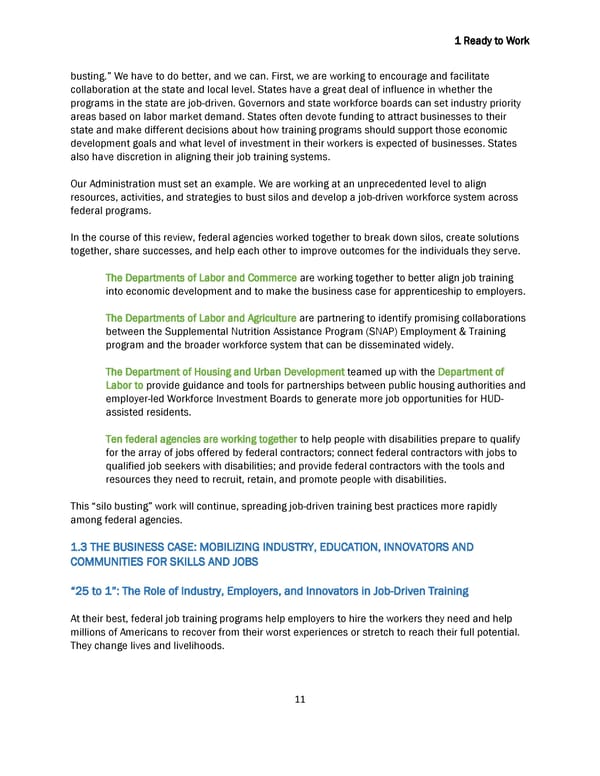1 Ready to Work busting.” We have to do better, and we can. First, we are working to encourage and facilitate collaboration at the state and local level. States have a great deal of influence in whether the programs in the state are job-driven. Governors and state workforce boards can set industry priority areas based on labor market demand. States often devote funding to attract businesses to their state and make different decisions about how training programs should support those economic development goals and what level of investment in their workers is expected of businesses. States also have discretion in aligning their job training systems. Our Administration must set an example. We are working at an unprecedented level to align resources, activities, and strategies to bust silos and develop a job-driven workforce system across federal programs. In the course of this review, federal agencies worked together to break down silos, create solutions together, share successes, and help each other to improve outcomes for the individuals they serve. The Departments of Labor and Commerce are working together to better align job training into economic development and to make the business case for apprenticeship to employers. The Departments of Labor and Agriculture are partnering to identify promising collaborations between the Supplemental Nutrition Assistance Program (SNAP) Employment & Training program and the broader workforce system that can be disseminated widely. The Department of Housing and Urban Development teamed up with the Department of Labor to provide guidance and tools for partnerships between public housing authorities and employer-led Workforce Investment Boards to generate more job opportunities for HUD- assisted residents. Ten federal agencies are working together to help people with disabilities prepare to qualify for the array of jobs offered by federal contractors; connect federal contractors with jobs to qualified job seekers with disabilities; and provide federal contractors with the tools and resources they need to recruit, retain, and promote people with disabilities. This “silo busting” work will continue, spreading job-driven training best practices more rapidly among federal agencies. 1.3 THE BUSINESS CASE: MOBILIZING INDUSTRY, EDUCATION, INNOVATORS AND COMMUNITIES FOR SKILLS AND JOBS “25 to 1”: The Role of Industry, Employers, and Innovators in Job-Driven Training At their best, federal job training programs help employers to hire the workers they need and help millions of Americans to recover from their worst experiences or stretch to reach their full potential. They change lives and livelihoods. 11
 Biden Ready to Work White Paper 7/22/14 Page 10 Page 12
Biden Ready to Work White Paper 7/22/14 Page 10 Page 12